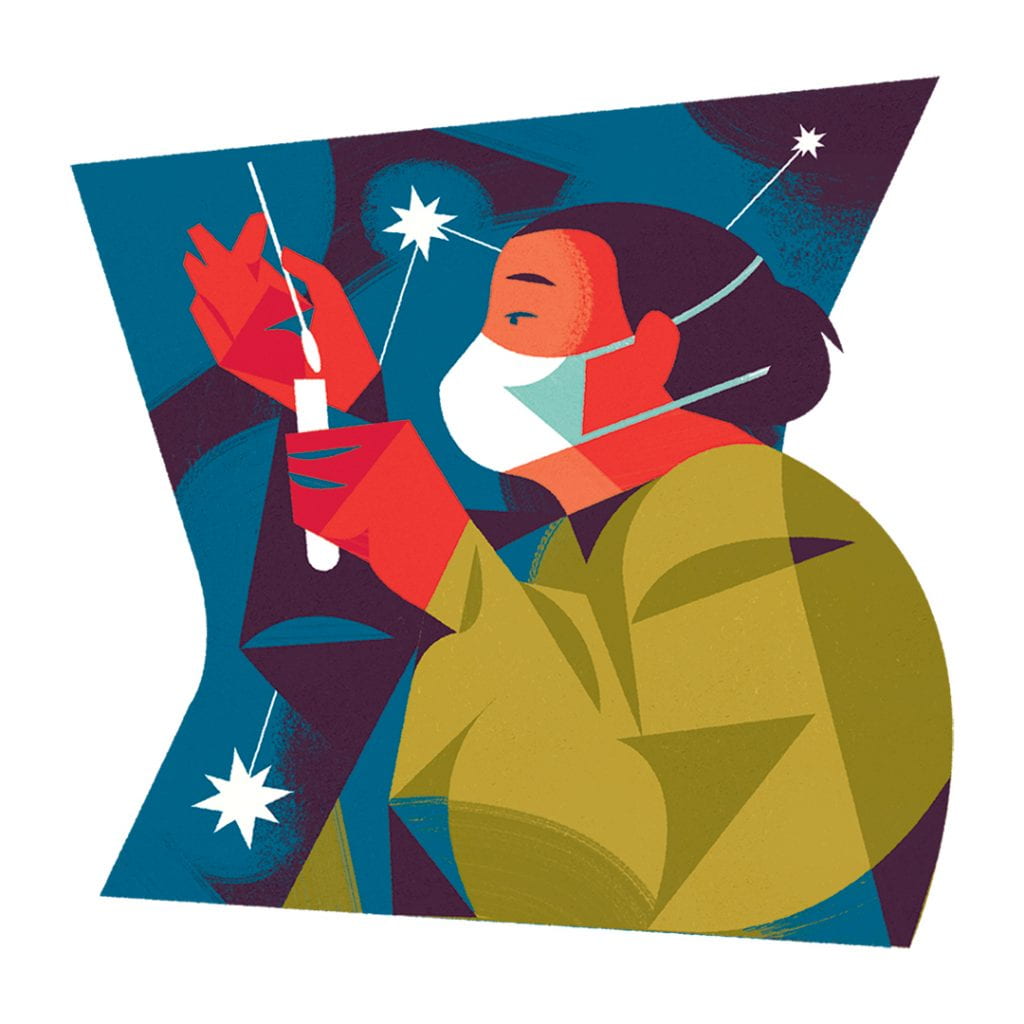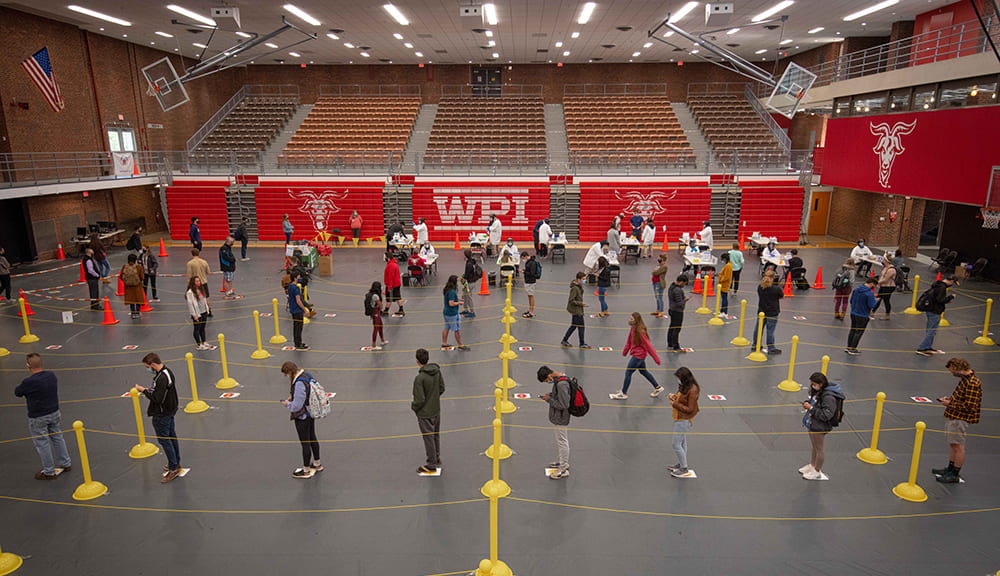Building a Response
Spaces, equipment, supplies take on a new significance during a pandemic.
Read StoryHow WPI built a health infrastructure to help manage a global pandemic
As the world faced down the highly contagious and sometimes lethal SARS-CoV-2 virus, which causes COVID-19, WPI had a singular goal in mind—its North Star—keeping the community as safe and as healthy as possible. But with a mobile, global population and an invisible disease, how could it even begin to do that?
At a university known for project-based learning, it’s no surprise that tackling this problem in a very WPI way was the key to its success.

Long before widespread closures, skyrocketing cases and fatalities, and deep fear settled in, WPI’s Health Services staff members had a simple routine; they took care of sick students. And while the conditions they helped manage and treat were varied, and some were quite serious, they had never seen anything like COVID-19.
In early spring 2020, in what seemed like the blink of an eye, everything changed. Health Services morphed into a pandemic response team focused on protecting the health and well-being of thousands of students and employees against a virus the world knew little about.
“In following the university’s Emergency Response Team design, because COVID-19 posed a health threat, WPI’s Health Services leader has served as the incident commander since we started meeting to track the progress of the virus back in January 2020,” says Ron Bashista, director of emergency management. “With community lives and safety at risk, and in the midst of a growing and evolving public health crisis with a lot of moving parts, this has turned out to be a massive, long-term, and critically important job. There were also significant personnel changes that posed challenges.”
Everyone was learning; it was trial by fire. And the pandemic response was all encompassing. We were trying to be prepared for every worst-case scenario.
Lisa Pearlman, Director of Health Services
As COVID-19 picked up speed in June 2020, the university’s health services director retired, taking advantage of a special early retirement incentive program. Upon her departure, Charlie Morse, associate dean and director of counseling in the Student Development and Counseling Center (SDCC), stepped in to lead; he spent the summer building a public health office from the ground up—assembling a health team, establishing COVID protocols and policies, and collaborating with others on campus to develop a plan for technical systems and dashboards, testing, tracking, and cleaning.
Thanks to his efforts, Lisa Pearlman, director of health services, came on board late in the summer of 2020 to take over the new Health Services team and continue building an infrastructure in time to welcome thousands of students back to campus.
“Everyone was learning; it was trial by fire,” she says. “And the pandemic response was all encompassing. We were trying to be prepared for every worst-case scenario.” With an immediate need to prepare for the campus reopening, the university also needed to have plans at the ready should an immediate shutdown be necessary. Those plans would be developed in concert with the Coronavirus Emergency Response Team (CERT); in fact, the team’s expertise was critical to directing the university’s rapid-fire response to health-related decisions. And in a pandemic, virtually every decision connects with health.

But merging health expertise and operational planning required additional competencies. Rachel (Bowers) LeBlanc ’02, associate vice president for strategic initiatives, joined the health team’s efforts in July 2020 when many structures were in place but many more were needed.
“When I came to the health team, we knew we were going to do COVID testing with the Broad Institute, and we knew we were going to need space for that,” she says. “We realized pretty quickly that we didn’t have the staffing to do this by ourselves.” New hires came on board, including Chloe Green as testing coordinator and Jen Hapgood-White as isolation and quarantine coordinator. A bit later, Emily Burke joined the team to bolster its contact tracing capabilities.
In true WPI fashion, LeBlanc says the team began with a broad assessment of the problems and possible solutions. They looked at what other schools were doing, remained looped into the state’s constant stream of policies and guidance, and became anchored to endless spreadsheets for any imaginable detail. Through all of this they worked closely with Emily Perlow, associate dean of students, and teams from the Facilities Office.
Dan Sarachick, director of the Office of Environmental Health and Safety (EHS), helped design the physical layout of the testing center in Harrington Auditorium (where tests would be collected and processed, and how traffic would flow, for example). He also developed and trained the Deep Clean Team, critical to the success of the testing program and many other aspects of WPI’s efforts to protect the health of the community. To reduce the risk of spreading the virus, the team cleaned areas in campus buildings where people who tested positive had been, including the isolation and quarantine spaces in the WPI townhouses, which ensured that these spaces would be ready should a surge occur. Later, he trained the Deep Clean Team to run the testing program after contracted observers had finished their assignment. The team took full control of the program in summer 2021, a considerable savings for the university.
“I have done a fair amount of systems engineering and that was helpful in determining the requirements, process, and definitions,” LeBlanc says, adding that the team approach made all the difference. “We all worked really closely, and the idea of no independent action [a CERT guiding principle] was important.”

The level of detail in the COVID-related health work is astounding, and one question invariably led to another.
“We started with a baseline for the testing, for example,” LeBlanc says, and then the scope broadened. “How often should people be tested: once or twice a week? What would the stations look like? How will individuals move through the testing site? How will we handle materials safety? What about testing people in residence halls or in fraternity or sorority houses?”
Every day brought new variables. Health team members had to identify any positive cases each day and find and notify all of their close contacts. They needed to figure out who needed to be moved into isolation or quarantine, and then set in motion all the cleaning that needed to take place.
We had a good system for detecting new cases. We paid attention to the data really closely and responded to it quickly, and that made all the difference.
Rachel LeBlanc, Associate Vice President for Strategic Initiatives
The team’s boots-on-the-ground tenacity to mitigate the virus meant everyone did what was needed. For example, if a student did not answer a call or return a message from the health team about a test result, the team moved quickly.
“We did whatever it took to isolate a positive case or quarantine a close contact quickly to make certain that no other community members were put at risk,” Pearlman says. “While it never proved necessary, we were prepared to station people in the hall outside a classroom to make sure an affected student didn’t go in, while also keeping the information private. We learned we couldn’t rely on outside organizations to do contact tracing. To keep this campus safe, we had to do it very quickly, and that meant we had to do it ourselves.”
LeBlanc agrees. “We had a good system for detecting new cases,” she says. “We paid attention to the data really closely and responded to it quickly, and that made all the difference.”

The behind-the-scenes work required the same approach. For example, creating technology to help the testing process flow smoothly was a learning experience in the pandemic’s early days, but the higher ed community collaborated to make it work, LeBlanc says. For example, the Broad Institute’s technology did not allow WPI community members to sign in by swiping their ID cards. Code provided by Tufts University made that possible. In the end WPI built, from the ground up, a cohesive testing and tracking system that was responsive to WPI’s specific needs and processes.
“Over a few short weeks,” says Patty Patria, vice president for information technology and CIO, “a small, dedicated team deployed symptom tracking technology, scheduling technology, and testing technology, which all fed into a centralized dashboard that allowed WPI to have its pulse on COVID in the community. Without these advancements, it would have been difficult to manage COVID last year.”

“WPI was on the leading edge,” Pearlman says. “Other health service directors were taking notes when I told them what WPI was doing.” Much of that progressive action, she says, was a direct reflection of CERT. “What’s unique about WPI’s response to COVID is CERT,” she says. “CERT is a constructive way to stay on top of the current situation and make decisions to respond. It’s an informed and collaborative way of making pandemic decisions. I’ve been unbelievably impressed by the knowledge and work ethic of CERT members. I’ve never met a harder working group in my life.”
LeBlanc says the need for quick decisions left no room for error. “Everyone was putting bricks down as people stepped on them and that’s how the path was made. We made it through the whole year. We didn’t close. The students were asked to make personal sacrifices, such as taking some classes in person and some online, wearing masks, and limiting group sizes, but it was in a safe environment. They felt safe and stayed healthy, and we never had major outbreaks.”
WPI was on the leading edge. Other health service directors were taking notes when I told them what WPI was doing.
Lisa Pearlam
The amount and variety of pandemic-related questions directed at the health team occasionally boggled them. “Even now, we get questions I never thought of,” Pearlman says. “I will get a question and think, ‘How is it possible this has never come up before? How is it possible I am still seeing something new?’” Everything from how to handle a test that was dropped on the floor and came back positive to discrepancies in close contacts’ recollections to how student athletes could sit safely on a bus—the health team was the go-to resource for information.
The team implemented increasingly complex structures, plans, case management, and processes, and some of these COVID-inspired changes will serve the university well in the long term. The health clinic branched into a well clinic and a respiratory clinic to separate healthy and sick students; Pearlman says that’s a feature worth keeping. Incorporating some telehealth visits for students could be helpful for flexibility as well.
“This showed all of us just how resilient this community is and just how much talent we have in this community,” says LeBlanc. Pearlman agrees. “I didn’t feel alone in making decisions,” she says, “and that’s why I appreciated having the health team and all the areas of expertise they brought. I’ve found this work to be the most challenging and interesting of my career. It’s incredibly valuable and important for people to be here on campus. And watching that happen made it very clear to me that the effort was worth it.”

Spaces, equipment, supplies take on a new significance during a pandemic.
Read Story